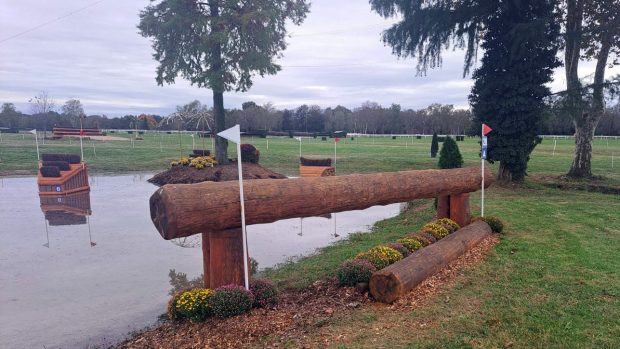Cross-country experience can benefit all horses, no matter what their eventual career will be. It teaches them to go forward and to take care of themselves and their rider over different types of terrain.
Sound preparation is the key to a positive mental attitude on the day with successful cross-country riding based on rhythm, balance and position.
Before entering a hunter trial, riders should be confident riding over differing terrain and have jumped a wide range of fences including water, ditches, combinations, arrowheads, jumps from light to dark and drops.
A secure lower leg acts in the same way as a seat belt in a car when riding across country. If anything goes wrong, the riders weight will be thrown forward and if your lower leg is already forward and secure you are less likely to part company with your horse.
Horses use their head and neck to help them balance so riders must allow them freedom to find their natural balance. By slipping the reins in a sticky situation the rider can enable the horse to use himself and help get the rider out of trouble.
On the day walk the course sensibly and thoroughly so you can see your intended route and all the fences in your mind’s eye. Don’t be influenced by other peoples’ views on how to ride the course, unless they know you and your horse’s capabilities.
Remember “what’s in the brain goes down the rein” so be positive with the instructions you give your horse. Try to ride away from the start with a confident attitude and make sure your horse is going forwards nicely with impulsion and approaches the first fence on a straight line.
If you suffer badly from nerves, ask a friend to come along with you on the day to help. If you’re going to be all fingers and thumbs and struggle to put on your tack your horse will pick this up. Having an acting groom to help and talk things over with can really help.
What to wear
The right clothing for horse and rider is vital if the partnership is to remain comfortable and safe during the competition. At some events your hat, body protector and condition of your tack will be checked before you are allowed to start.
For the rider:
- Riding hat which meets current safety standards — BS EN 1384 or PAS 015
- Body protector to conforms to current standards
- Cross-country shirt in your own colours (long-sleeved to protect your arms if you should fall). A hacking jacket would also be correct for a hunter trial
- Hat silk and hair neatly fastened – tied back, plaited or in a hair net
- Breeches and either long boots or shortboots and gaiters
- Jumping whip and/or short spurs (if needed)
- Non-slip gloves
- A hunting tie or stock will help to support your neck if tied correctly
For the horse:
- Good quality and correctly-fitting tack in good repair — check the stitching before every event so necessary repairs can be made
- Reins with a non-slip grip
- Stainless steel stirrups
- Numnah or saddlecloth to provides cushioning under the saddle
- Breast plate or breast girth to keep the saddle in position
- Martingale if needed
- Overgirth or surcingle in case your girth fails — correctly fitted to prevent pinching
- Boots all round to provide good protection against strikes, knocks and injury to lower leg
- Correctly fitted over-reach boots (be careful they are not too big or the horse may tread on them and trip up)
The importance of studs
Correctly chosen and fitted studs will give your horse confidence, as well as offering a psychological boost to the rider.
From their very first hunter trial as four-year-olds, all Ian Stark’s eventers wear studs to a similar pattern.
“We don’t use studs at home, but for competing they have road studs in the front and pointed jumping studs behind.
“If it’s wet and slippery, we put huge studs in the back. I dont like anything too big in the front because, if a horse cant slide, he will jar his shoulders.”
Ian has ignored the growing trend for eventers to use studs on both the inside and outside of the shoe.
“I’m terrified they’ll stand on themselves and do some damage,” he explains.
Having tried plugging stud holes with everything from cotton wool to rubber stops, Ian says: “Nothing works brilliantly. You just have to get to work with a nail.”
H&H Online Tip: Cleaning out and oiling nail holes should be done the day before the event to save time and frustration on the day.



